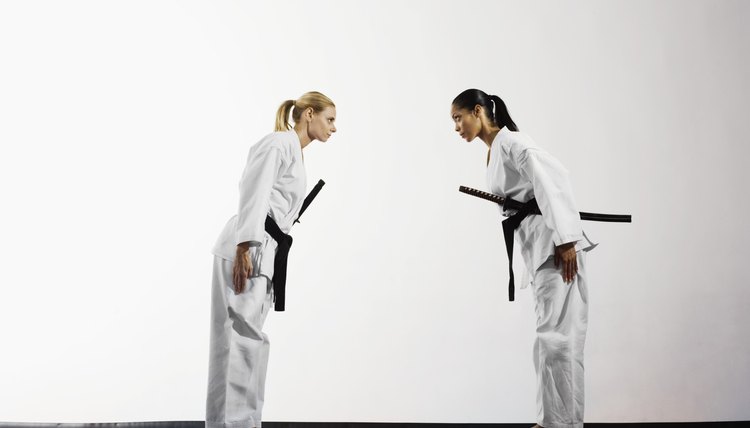Kenjutsu Techniques

Kenjutsu is the ancient swordfighting martial art of the Japanese Samurai class, which reached its height during the 15th and 16th century. Many people around the world practice the sport form of kenjutsu, called kendo, but the two have many differences. Kenjutsu has no restrictions or point systems in its fighting form, and is steeped in martial arts tradition. Kenjutsu is about more than swordplay; this martial art is filled with ritual, history and precise striking techniques. Practitioners of kenjutsu maintain a delicate balance between the traditional techniques of the martial art and the constraints of modern day sporting applications.
Five Fighting Postures
Kenjutsu operates from five primary stances, or Itsutsu No Kamae. The five fighting postures are sword held overhead, sword held to the side, middle thrust, sword pointing down and horizontal. The five postures are linked together in a chain of motions that allow the swordsman to adapt to any battle condition. These five postures are the basis for kenjutsu training and conditioning. The stances build muscle memory and motor learning, drilling the techniques into your body through repetition.
Quick Strikes
Kenjutsu has a number of quick strikes in which one hand remains on the pommel of the sword and the other hand rests on the ridge of the blade itself. This hand posture and similar variations in posture allow for strikes with the katana, or sword, that rival the speed of arrows. These quick strikes don't require a feint and can be launched from several starting positions. Targets for quick strikes include the wrists, collar, groin and neck. Quick strikes not only strengthen the muscles of your forearms and wrists, they also enhance hand-eye coordination and overall speed.
Forward Thrust
The sword thrust is one of the main fighting techniques of kenjutsu. The strategy behind thrusting is to first lure your opponent into an ill-timed strike. This is accomplished through a subterfuge. Fake your intention to draw your opponent in and then perform a double-handed forward thrust, targeting the face or chest. Kenjutsu thrusts are always preceded by a false strike or a circling motion, used to move the opponent's blade.
Cleaning the Blade before Sheathing
Before sheathing the blade, swing the katana over your head in a fast, circular motion or flick the blade with a quick flick of the wrist. Circle the sword in front of you and slide the point across the opening of your sheath. Slide the blade into the sheath with the right hand and move the sheath over the blade with your left. The two arms move together and meet in the middle. Kenjutsu has many rituals and techniques surrounding the proper handling of your blade. Everything from the way your sword is carried to the way you clean blood off the blade is carefully orchestrated. Modern practitioners of Kenjutsu might never have a practical use for these techniques, but maintaining them is part of the kenjutsu tradition.
Double Sword Technique
Some kenjutsu practitioners have been known to fight with two swords, a technique popularized by renowned swordsman Miyamoto Musashi. Fighting with a sword in each hand doubles the offensive and defensive capabilities of the swordsman, but this technique requires its own type of intensive training. Essentially, while one sword is blocking your opponent's strike, the other sword is used for simultaneous thrusting and cutting. The double sword technique is still practiced today and taught to initiates of the kenjutsu sword-fighting art.
Resources
Writer Bio
Frederick S. Blackmon's love for fiction and theater eventually led to a career writing screenplays for the film and television industry. While living in Florida, Blackmon began exploring issues on global warming, health and environmental science. He spent two years as a Parkour and free-running instructor as well. Now he writes everything from how-to blogs to horror films.
